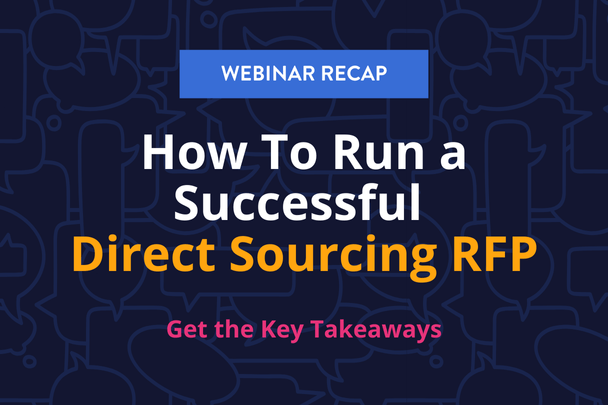Learn how to build an engaged talent community through direct sourcing Candidate Sourcing Strategies of contingent talent
Who hasn’t experienced the frustration of raising a hand that goes unnoticed? Being ignored may be momentarily uncomfortable for one party, but it can have longer-term consequences for the other. Ignoring opportunity is exactly what employers often do when searching for contingent talent. They look right past people they already know or those who have essentially “raised their hand” to express interest at a branded career site, in favor of seeking out new talent in a rapidly shrinking talent pool. Connecting with people who already know you or want to know you ⎯ via “direct sourcing” ⎯ can lead to higher-quality contingent talent, speedier hiring decisions, quicker onboarding, and a shorter productivity ramp, all at a lower cost.
Are you ignoring your best contingent talent prospects?
Ask anyone about the best ways to secure talent, and the answer that always rises to the top is “referrals.” Under the theory that good people know good people, most employers have some type of referral program in place to take advantage of employee networks. Many of these programs, however, are loosely administered and often suffer from benign neglect. Few specifically look to source contingent talent, which is an increasingly vital component of today’s workforce, now approaching 47%, as reported by The Future of Work Exchange. There is strong evidence that capitalizing on personal connections in recruiting is a smart strategy in hiring. Based on an analysis of customer data, PageUp found that job boards required 46 applicants to produce a single hire. The ratio for corporate careers sites was better at 26:1, but blowing both away was the success rate for referrals at 5:1.
Do traditional candidate sourcing strategies still work?
The most successful matches of talent to task can also be found in personal connections between candidates and recruiters, yet contingent talent sourcing has traditionally been an impersonal process. Attracting contingent talent typically had more to do with the way work was described than about the company that needed help. It was a numbers game, with recruiters measuring performance based on how many applicants apply for every role. That may measure the effectiveness of a job posting, but it doesn’t tell you how well your recruiting process is working.
With job boards and social media, the number of applications skyrocketed as it became easier for employers to post job opportunities to multiple sites and for applicants to apply to multiple jobs. Recruiters were quickly overwhelmed, with little ability to appropriately evaluate candidates, let alone get to know them. The introduction of powerful technology that automated the most transactional aspects of sourcing offered gains in speed, but it put the human element in the process at the mercy of algorithms and keyword matching.
Today’s recruiting strategies blend traditional sourcing with automated processes to balance technology and human touch in ways that add efficiency without eliminating the ability of recruiters to make connections and build relationships. That supports an increasingly critical focus on candidate experience. Better yet, in a labor market plagued by too few candidates to fill the number of open jobs, recruiters have uncovered new “direct sourcing” channels that leverage the power of the client brand to attract high-potential candidates to contingent roles.
What is direct sourcing and how does it differ from traditional staffing?
Direct sourcing is a talent acquisition strategy that capitalizes on an organization’s brand and its own networks to fill contingent roles. In direct sourcing, the sources of talent originate with the client organization, starting with its own applicant tracking system and network of contacts. These might be alumni employees, retirees, silver medalists (direct hire candidates who came close but were not ultimately hired), employee referrals, former interns, visitors to a company careers site, and other “pre-identified talent.” The latter are individuals who may have supported the business in the past as project consultants, independent contractors, or staffing agency hires. They already may be payrolled by one of the company’s staffing agency partners.
In traditional staffing, a staffing agency manages contingent talent sourcing on behalf of a client. When a staffing agency reaches out to potential candidates, whether via job boards, social media, paid advertising, job fairs, professional networks (such as LinkedIn), etc., job applicants rarely know the name of the client they might be hired to support. In direct sourcing, potential applicants already know the brand and its reputation and have some level of engagement with and interest in the business.
There is more to direct sourcing than simply identifying potential candidates. Once individuals are identified, they are invited to become members of the organization’s branded talent community, becoming a ready resource to fill contingent (and maybe even full-time) roles in the future.
What is a talent community? Is it the same as a talent pool or talent pipeline?
Terms like talent pool, talent pipeline, and talent community are often used interchangeably, because they all carry similar meanings, i.e., a group of available candidates with the right skills and experience to potentially fill a role. If you think about a talent pool as a passive source of talent and a pipeline as a more focused and targeted source of talent, then a talent community is where all the talent gathers.
That said, a talent community is more than a waiting room for potential hires or a listserv for email blasts. It is a relationship-based proposition that requires ongoing interaction between candidates and the brand. Two types of individuals accept an invitation to join a company-branded talent community:
- Active candidates who are immediately interested in contingent opportunities.
- Passive candidates who are interested enough to follow the brand and appreciate the opportunity to maintain a connection to the brand, but not necessarily convinced that a contingent position with the brand is right for them now or ever.
In both instances, candidates in a branded talent community want to know more about the company’s activities, its culture and values, its employees, and its employment opportunities. And the end goal of the talent community is to entice them to work for that brand in the future. To keep talent warm until the right opportunity surfaces requires proactive and appropriate communications that engage and add value.
Talent curation is a critical element of direct sourcing.
It’s not enough to simply gather interested candidates in a branded talent community. Direct sourcing can ensure qualified candidates are well-matched to needed positions, and it can do so quickly and efficiently through talent curation. What do we mean by that? Curating candidates is a proactive means to segment a talent community, focusing on specific details that help refine selection criteria. When you identify and categorize candidates, based on role, experience, skills, location, compensation expectations, and other details that contribute to a solid match, you can speed up the selection process and accelerate hiring decisions, onboarding, and productivity. And when candidates choose to share diversity data, it’s possible to build diverse talent pipelines to support DEI initiatives. Talent curation also allows you to provide more targeted content to boost candidate engagement through recruitment marketing.
What resources are needed to automate, measure and optimize direct sourcing?
Direct sourcing success requires the technology to automate workflows relating to activities such as AI and algorithmic matching of candidates to roles, recruitment marketing, candidate relationship management, and candidate curation.
There are a number of direct sourcing technology solutions available today, including TalentNet, LiveHire, WorkLLama, and WillHire. Each of these leading solutions makes it easy to initiate a direct sourcing program that can expand the pool of high-potential candidates and more quickly close the gap between surfacing a need and filling it.
It’s also possible the technology tools you are already using for talent acquisition (e.g., ATS or CRM) and workforce management (e.g., VMS) can accommodate the addition of a direct sourcing component, without a lengthy implementation ramp.
The most successful programs also have dedicated resources to manage transactional program elements. Companies often work in tandem with their MSP partner to manage direct sourcing recruiting and serve as the employer of record for onboarding and payment processes, for example.
What is the future of contingent candidate sourcing?
A business cannot focus on growth when it has to spend lots of time filling empty slots. Leveraging your brand to attract and curate the best contingent talent offers another proven strategy to help you build a high-performance workforce. With the right processes and technology, supported by the expertise of a workforce solutions partner, you can successfully tap into the power of your own brand to establish a robust talent pool and find the people needed to fuel business growth. In our next post, we’ll take a deeper dive into the art and science of talent curation. In the meantime, you can learn more by accessing our on-demand talent curation webinar. It features an outstanding panel of industry experts who share their insights on the power and potential of talent curation and direct sourcing.








